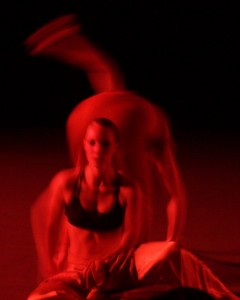‘Happy Hour’ with Flute and Trumpet
May 18, 2010Tonight, Monday, May 17, there was a “Happy Hour” starting at 7:30 p.m. at Idyllwild Arts. For nearly two hours, two classical music seniors, Yeon Jung, a flautist, and Yi Ling, a trumpter, gave one of the best performances of their young lives, and everyone who came, left happy.
Not only are they good friends, but both are going to the Boston Conservatory of Music in the fall.
First up was Yeon Jung, who wore a long, strapless black form-fitting gown. Her long hair was pulled back from her face, and she wore no jewelry. But, it didn’t matter, because her flute was golden.
Jacob, a saxophone player from the Jazz Department, said that her flute was made of gold, and that it had a rose-colored coating on top.
“That flute is really amazing,” he said. “And William got to play it.”
“That flute has a sweet sound,” said William, another flute player in the Idyllwild Student Orchestra. “I got to play it last week, and it creates a wonderful sound. You can definitely tell the difference.”
To start, Yeon Jung played a short piece, “Sonate in E Minor, BMV 1034,” by Johann Sebestian Bach. Anni Cao, another music student, was her piano accompanist.
Yeon Jung played with her music stand and sheet music in front of her. Yet, when she played, she moved to the music. At times, she would move closer to the music to clearly see the notes, then sway from side to side, enjoying the sound coming out of her instrument.
Yeon Jung’s second piece was longer, “Concerto,” by the French composer, Jacques Ibert. It was more intense than the first, with many scales up and down the register. In the “Allegro” part of Ibert’s “Concerto,” she hit a high C, and stood on her tippy toes to reach it.
Jacob, who also plays the flute, was impressed.
For her third piece, Yeon Jung played a duet with Young, a classical guitarist, who had his recital last week (see ‘A Night with the Young Masters’ blog from May 13, 2010). Young sat with his guitar, while Yeon Jung stood.
They played a short piece, “Bordel 1900,” History of the Tango, by Argentine composer Piazzolla. When Yeon Jung would play, Young would respond by playing a few notes, then tapping a beat on the outside of his guitar. It sounded more like a drum, yet had a nice, commanding effect.
The flute and guitar seemed natural together, and Young played soft as a good accompanist. Although it was a lively, short piece, it was memorable, especially the final note.
“She held it for a long time,” Jacob said, obviously impressed.
For anyone who has ever played the flute knows that its hard to do–because you’re blowing across a hole all the time. Yeon Jung had great lung control throughout her 45 minute recital tonight.
Yeon Jung’s final piece, “Suite of Three Pieces, Op. 116,” by B. Godard, was broken into three sections, allegretto, idylle, and valse. Naturally, living in Idyllwild, the “idylle” section interested me. It actually sounded like mountain music, with low notes and trilling that sounded like birds.
After her recital, two of her friends came forward with bouquets of flowers. Her flute teacher, who came all the way from Redlands, was complimentary, and posed for pictures.
After a brief intermission, it was Yi Ling’s turn. He was impressively dressed in a black suit that had ribbons around the lapels and pockets. His good friend and accompanist, was Ie-Seul, who also wore a black jacket and pants.
“Sonata in C,” was Yi-Ling’s first piece, by Purcell. It was short and a good warm-up. At the onset, you couldn’t help but notice the clear, confident sound coming from his trumpet.
For his second piece, Yi-Ling was accompanied by his trumpet teacher, David L. Scott, onstage.
The two, with their silver trumpets, created such a loud sound, that those in the front row could feel their teeth rumble. Imagine playing next to them in an orchestra? Yet, their duet, “Concerto in C for Two Trumpets,” by Vivaldi, was so rewarding, that it was worth it. One would lead, then a half beat later, the other would follow. They played clearly, and effortlessly, like two seasoned musicians.
For his third piece, Yi Ling played, “Sonata for Trumpet and Piano,” by Kent Kennan. But before he played, Yi Ling spoke for the first time.
“I’d like to thank you all for coming,” he said shyly, then thanked his trumpet teacher, his friends, family, accompanist, and even his van driver, Ron St. Pierre, for taking him to music lessons.
“I’d like to thank my teacher, David Scott, for 4 1/2 years,” Yi-Ling said. “It’s really been an honor.”
After all of his thanks, Yi-Ling got a little choked up and teary eyed before he began his next piece. Perhaps the fact that he was going to graduate in less than three weeks was starting to hit him.
For his “Sonata for Trumpet and Piano,” Yi-Ling placed three trumpet mutes on the stand next to him.
“They’re straight, harmon and tap,” Jacob offered. He knew about trumpet mutes because his good friend at school, Caleb, is a jazz trumpeter.
Not only did Yi-Ling have to play a long, complicated piece, but he had to add the mutes at different times. Each mute created a different sound.
The mute that Yi-Ling used on his last piece, “Trumpet Concerto in A Flat Major,” sounded the best. In fact, this piece, created by Arutunian, was Yi-Ling’s commanding finale. He spoke again.
“This is the perfect piece to express myself,” he told the audience of classmates, faculty and friends. “It’s a good piece to end my recital because I’ve learned new things, and grown up a little bit. Thanks again for coming.”
“What a sweet guy to thank us for coming to his recital,” Mariya, a bassist, said.
The concerto, was a workout for the Ie-Seul, the pianist, too. But it wasn’t beyond her realm.
“That pianist was a student?” Ron St. Clair, Yi-Ling’s driver, asked later. “I thought she was a teacher. Wow.”
Towards the end of the piece, Yi-Ling added one of his mutes, and Ie-Seul stopped playing all together. All alone, Yi-Ling and his trumpet sounded like Miles Davis playing “Sketches of Spain.”
“Him playing alone was a nice effect,” said Karin Obermeyer, a literature teacher at Idyllwild Arts, who attends most of the recitals.
Ie-Seul came back briefly for the finale, which ended sooner than we all wanted that night. After his final note, everyone got to their feet.
When Yi-Ling thanked his teacher and hugged him afterwards, the emotions began to flow. Shi-Shi, a violinist, who came to the recital, began to cry.
Ie-Seul, who was the piano accompanist for nine of her friends, also felt the finality. “This is my last recital where I was an accompanist,” she said.
You would think that she’d feel relief, instead of tears. She wiped them away and smiled. Just like everyone who left the recital that evening. Another musical performance well done.
More senior recitals are forthcoming until the end of the month. Visit www.idyllwildarts.org, and hit “Academy,” and then “Center Stage,” for details, or call (951) 659-2171.






















